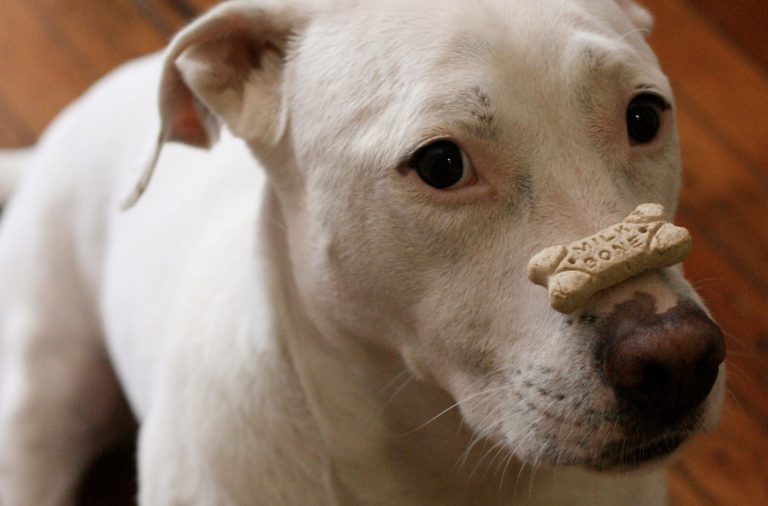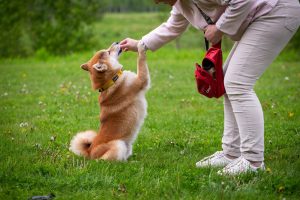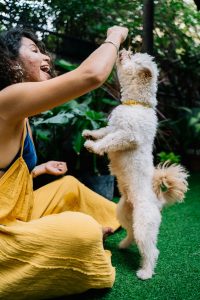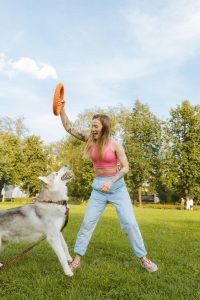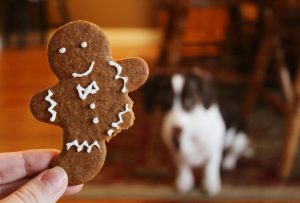Let me ask you a simple question. Does your dog only listen to you when you have a treat in your hand? Or does he listen to you without any treats involved? Well, if the answer to the first question is yes, you are not properly luring your dog. What you are doing is you are bribing your dog.
And there is a big difference between these two. If you are only bribing your dog, you will have to increase the value of your bribe as time goes on. He will ask for a higher-quality bribe. And that will hamper your training.
Lure and reward training is one of the best ways to train your dog. It is a simple and relatively quick way to teach your dog proper behavior. You can also use it for some tricks, just for fun. But essentially, lure and reward training is something you do to teach your dog what is acceptable behavior. You lure and stimulate good behavior.
For example, you can use lure and reward training to teach sit, down, movements like heel, and much more. And because people often struggle with luring, we have to talk about the difference between luring your dog and bribing.
If you feel that your dog listens to you only when you have a treat (bribe) in your hand, you better read the article. Bribing is a sign you have missed a crucial step in the teaching and training process.
Main difference between lure and bribe
Lure reward training is an essential asset for classical conditioning, operant conditioning, and any other form of training. The most important part of the conditioning (training) is the stimulus with a pleasant outcome. This can be food, toy, affection, happiness, or anything else. In most cases, we use food.
Reward training is an easy and better way to do classical conditioning. But we have to understand the difference between lure and bribe.
We give lure beforehand to teach the animal what you want him to do. The lure in this case causes the behavior. The reward comes after the behavior. You do not promise the dog a reward beforehand. Or in other words, your dog doesn’t know what he will get after he performs the behavior.
The lure teaches your puppy to do what you want.
If you show your dog the treat beforehand, the lure becomes a bribe. And when food and treats become bribe, not praise and lure, you have a problem.
When do you give the lure? You give the lure to the top after the behavior but doing the behavior. If you are using food as a lure and your dog suddenly becomes willing to do the behavior, you are essentially bribing, not luring.
Unlike lures, a bribe is shown beforehand to coerce an unwilling dog to do something you want. For example, if your dog doesn’t want to come to you, you show the treat in your hand, and he comes. Have you lured him or have you bribed him? We know the answer, hopefully, you understand it now as well.
Bribes might work with small puppies. But as they grow older, somewhere between 6 and 8 months, if you still have food in your hand beforehand, you are essentially bribing.
What does that do? Well, you now have a dog that will do something only if you have food in your hand. And with time, that bribe will become bigger and bigger.
Another way to explain the difference is luring is a technique that will teach the dog what we want him to do. But he is absolutely willing to do it. With bribing, on the other hand, the dog is not willing to do it. He thinks he can do it anytime, and he does it when he wants it because you have offered a bribe.
The dog will often blow off the bribe and you have to increase the value of the bribe. You start off with kibble, then you move onto treats, and then even some cheese, meat, and so on. Increasing the level of the lure (bribe) will not work. It only gives you a temporary boost in behavior.
The Basic Lure Reward Training Sequence
To help you understand how to lure your dog better, we will talk a bit about the basic lure reward training sequence.
The lure and reward method uses a treat to lure the dog into different behavior. Now, we do show the lure beforehand in the beginning. Why? Because we want the dog to follow the pattern and perform the behavior we want.
How to do it? Simply hold a motivating treat to your dog’s nose, and slowly move it around to get him to move the way you want. Think of treats as a magnet for your dog’s nose.
Where his head goes, his body will follow. And his head will follow the lure.
After your dog performs the behavior, it is time to reward him. This way, your dog learns that he did what you wanted.
Where do most owners make a mistake? They continue luring with a treat. In reality, you need only a couple of repetitions with food in your hand so your dog gets to the right position and gets the right idea. Yes, some dogs might need more time than others. Remember, dogs have different levels of intelligence. Some dogs are easier to train.
Generally speaking, you need to repeat the movement a couple of times. Then, repeat the hand motion but without any food. If your dog follows the empty hand the same way he followed the treat, you have done well. Reward him with a treat afterward if he performs well.
With time, the motion with your empty hand becomes a hand signal for your dog. At this point, you can also add a verbal cue. Adding a cue is a crucial part of the learning and training process. Some people do only hand signals. Others stick to the verbal cues. We will go into the difference between the two in another article.
Now, what is the basic training sequence? There are four parts of the basic training sequence. And lure is the second part. Here is the basic training sequence.
1 – Request
2 – Lure
3 – Respond
4 – Reward
The first step is you request a behavior, the second one is luring the dog, your dog responds to your request, and now you reward him.
Let’s see some examples. For example, teaching your dog to bark on cue. The basic training sequence looks like this.
1 – Give the command speak (or anything suitable)
2 – Lure your dog with something that triggers barking (doorbell for example)
3 – Your dog responds and barks
4 – Reward the barking
Now, teaching barking is an essential part of teaching dogs to stop barking. For that, the basic learning sequence looks something like this.
1 – Give command Shush
2 – Bring something to your dog nose to sniff, he cannot breathe through the nose and bark at the same time
3 – Your dog sniffs the food and stops barking
4 – Praise your dog, good shush, good dog, and then give him the food
Do not worry, we will talk more about how to stop a dog from barking more in another article. The important part is to understand the basic learning sequence. And all of that works when you hand feed your dog.

